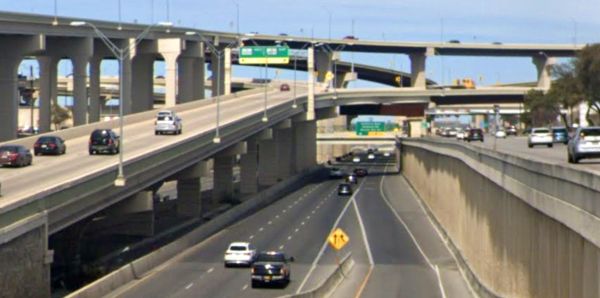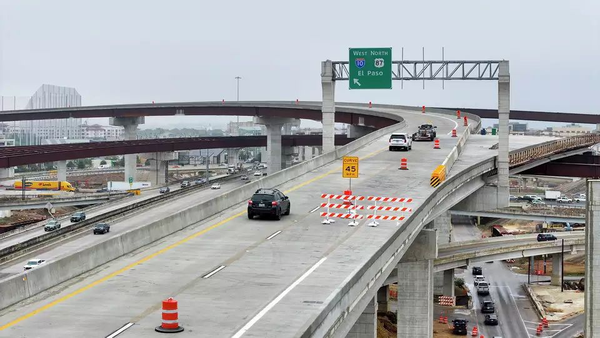|
|
|
|
|
This page last updated September 13, 2025 |

One question I get with some regularity regards the height of local interchange flyovers. Texas is notable in that the state builds spectacularly tall interchange flyovers, and their height is often a topic of curiosity. San Antonio was a bit of a latecomer to the high-flying interchange party, with the first modern "Texas-style" stack interchanges starting to rise from the ground here in the first decade of this century. Prior to that, the tallest interchanges here topped out at about 65 feet. But there are now five interchanges that have at least one flyover that's 80 feet tall or higher, and two more under construction will have flyovers at least 120 feet tall, which will be the tallest in the area and among the tallest in the state.
Given that, I thought it was time to compile a list of the tallest interchange flyovers in San Antonio.
|
ADVERTISEMENT |
Why are Texas flyovers so high?
Before delving into the actual heights of local interchanges, I have to answer the question that inevitably comes-up: Why are Texas interchange flyovers so tall?
If you search the Interwebs, you'll find that, like many things, there's not a single answer, but rather a combination of factors. And no, it's not a Texas "flex". It's worth mentioning that while tall interchanges are widely seen as a Texas phenomenon, you'll find similarly tall interchanges now in other states such as California and Florida.
First, older interchanges were generally only built with the minimum clearance between levels (15 or 16 feet), whereas with modern interchanges, engineers typically provide an additional few of feet of clearance between levels for added safety, future-proofing, and as a requirement of the state's designated freight network, which requires 18½ feet.
Second, those older interchanges were built with shorter bridge spans using smaller girders, typically less than five feet in height. Today's interchanges use longer spans with fewer columns. Those longer spans require heftier girders, oftentimes eight or nine feet high. These larger girders, plus the additional clearance mentioned above, can add 5-10 additional feet per level and therefore are a big reason for the additional height in contemporary stack interchanges.
To summarize, here are the reasons why modern flyovers in Texas are so tall:
- To provide a higher clearance of 18½ feet in accordance with the Texas Freight Network requirements.
- They use longer spans than older interchanges, which requires bigger girders, most of which are half-again as tall as the girders used in older interchanges.
- The ramps are often built for a higher speed than older interchanges, meaning more banking and minimal undulation, which adds a bit of additional height.
- Many Texas interchanges also have continuous frontage roads, which requires a fifth level.
When you add all those together, you can have about 25 feet or more required for each level, resulting in interchanges with the top level oftentimes exceeding 100 feet.

Methodology
Determining the height of a particular flyover is not as easy as it may seem. Both the structure itself, as well as the ground below it, are not level, with elevations varying continuously across the length. On curves, banking will cause a significant variation in elevation laterally across the bridge deck. And on the ground, besides the varying terrain, one big question arises: should the extra height that a depressed roadway adds be included in the calculation?
So for my calculations, I used the following methodology:
- The elevation of the flyover was determined along the centerline of the roadway on the top surface of the bridge deck.
- The flyover height at a spot was calculated by subtracting that elevation from the elevation of the ground directly below, whether that's the natural ground level, on a man-made embankment, or in a depressed location.
- For flyovers that pass over roadways depressed below grade, I show two top heights for that flyover: one for the tallest point over the depressed roadway, and one for the tallest point over a location that's at the normal ground level. You can decide for yourself which counts. 😉
- I didn't calculate the elevations at specific intervals along every flyover. Instead, I field surveyed each interchange and determined anecdotally where the tallest spots were, then performed the measurements in that area using trial-and-error until I found the highest point.
- The elevations for completed interchanges were taken from Google Earth. To help ensure accuracy, I took multiple measurements from different angles. If there were discrepancies, I used my best judgment to reconcile them. Because of this, measurements obtained via this method should be considered approximate and could be off by a couple of feet.
- For interchanges under construction, the heights come from bridge profile elevations in the construction plans. Once they are completed and appear in Google Earth, I will reconcile the height in the plans with the measurements from Google Earth.
Tallest interchange flyovers in San Antonio
The following table lists all flyovers in San Antonio over 80 feet tall, with the height at the highest point on the flyover shown. The table is sorted to keep all the flyovers in each interchange together with the interchanges ranked by their tallest flyover.
As mentioned above, if a flyover crosses over a depressed section of roadway, one height will be shown for the highest point over the depressed road, and one for the highest point over normal ground level along an adjacent roadway. Locations over a depressed roadway are marked with an asterisk (*).
| INTERCHANGE | CONNECTOR | HEIGHT |
  |
WB 1604 to EB 10 Over existing lower level Over future NB lower level access road (Opened August 28th, 2025) |
126' 128' |
| EB 1604 to WB 10 Near center of interchange over lower level Park & Ride (Opened December 3, 2024) |
123' | |
| EB 1604 to EB 10 Over I-10 EB access road (Opened September 13, 2025) |
106' | |
| WB 10 to WB 1604 Near center of interchange over lower level Park & Ride (Opened June 2nd, 2025) |
101' | |
  East |
WB to SB Over EB 10 collector/distributor (Opened August 18th, 2025) |
122' |
  |
WB to SB Over NB 281 mainlanes* Over eastern turnaround |
109' 87' |
| EB to NB Over SB 281 mainlanes* Over SB access road |
100' 84' |
|
  |
EB to NB Over SB access road* Over SB 410 mainlanes |
93' 87' |
  |
EB to NB Over WB access road |
88' |
| EB to SB North of Halm Blvd. |
85' | |
| WB to SB Over EB 410 mainlanes. |
81' | |
  |
SB to WB Over NW cloverleaf |
88' |
  Northwest |
EB 10 to EB 410 Over WB 410 mainlanes and collector/distributor |
85' |
| WB 410 to EB 10 Over EB collector/distributor |
82' |
Here are a few other interchanges that may be of interest:
- Loop 1604 at US 90: 66 feet over the westbound US 90 mainlanes
- Loop 410 at Bandera Rd: The westbound flyover to northbound Bandera is 55 feet over the western turnaround at Evers Rd.
- I‑37 at Loop 410: 65 feet at the center of the interchange
- I‑10 at I‑37: 65 feet at the center of the interchange
- I‑10/I‑35/US 90: 64 feet at the center of the interchange
The I‑35 NEX project will also have some tall flyovers; however, as a design-build project, the plans were not readily available, so I don't have height information on them yet.

